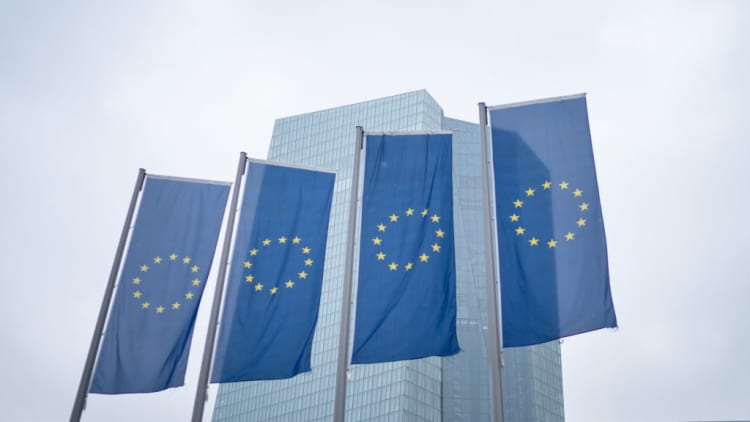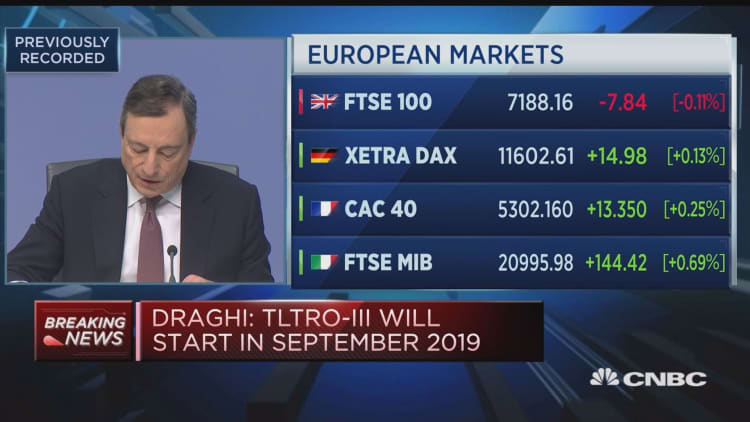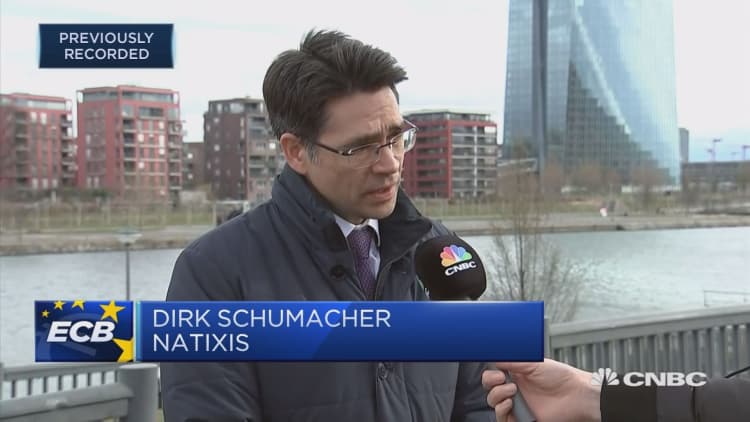
The European Central Bank (ECB) announced another program to stimulate bank lending in the euro zone on Thursday, as well as pushing back the timing of its first rate hike.
"A new series of quarterly targeted longer-term refinancing operations (TLTRO-III) will be launched, starting in September 2019 and ending in March 2021, each with a maturity of two years," the central bank said in a statement.
The TLTROs are loans that the ECB provides at cheap rates to banks in the euro area. As a result, lenders are able to provide better credit conditions to customers, which in turn stimulates the real economy.
TLTRO III is the third injection of stimulus of this kind from the ECB. If commercial banks lend this money onto the real economy, they then receive cash rather than having to pay interest on the loans.
This mechanism was introduced for the first time in 2014 and a second time in March of 2016. The central bank's decision comes at a time when there are increasing concerns about growth in the euro zone. The economy continued its lowest pace of growth in four years during the final three months of 2018, data showed in January.
ECB President Mario Draghi also cited a series of external risks as a reason for the new measures.
"The persistence of uncertainties related to geopolitical factors, the threat of protectionism and vulnerabilities in emerging markets appears to be leaving marks on economic sentiment," Draghi told reporters Thursday.

Rate hike pushed back
The bank also kept interest rates unchanged Thursday but updated its guidance for a rate hike. Interest rates on its marginal lending facility and deposit facility will remain unchanged at 0, 0.25 and -0.40 percent, respectively. These have been at record lows for years following the euro sovereign debt crisis of 2011 in an effort to boost inflation and stimulate growth.
The ECB had previously said that rates would remain at these levels through to the end of the summer. But Thursday, it said it now expects its key interest rates "to remain at their present levels at least through the end of 2019."
The euro zone's central bank, for those nations that share the single currency, ended its massive bond-buying program back in December but is now unveiling yet more stimulus in the face of weakening growth and external risks.
European bond yields fell on the announcement. The euro also traded lower against the dollar at $1.1251 at around 2.00 p.m. London time Thursday. European banking stocks turned positive on the news but erased gains later in the session.
Uncertainty in the region
Draghi said Thursday that there had been a "sizable moderation in economic expansion that will extend into the current year."
The 19-member region has been overshadowed by political developments in Italy, which entered a technical recession at the end of 2018; and in the U.K., where its departure from the EU has yet to be finalized. There are also concerns about a potential slowdown in the Chinese economy, given a reliance on exports to the country.
Back in December, the ECB forecast a growth rate of 1.7 percent for 2019. Since then data have shown that growth has been more moribund than expectations. The ECB slashed its growth forecast for 2019 to 1.1 percent on Thursday.
The OECD (Organization for Economic Co-operation and Development) said Wednesday that it expects the euro area to grow at only 1 percent this year.
The Frankfurt-based institution is in a tricky situation, having ended its massive bond buying purchase program. Growth seems to be stalling this year and core inflation is still below the bank's target.

Sign of panic?
Carsten Brzeski, the chief economist ING Germany, questioned whether the ECB's move was a sign of panic or an attempt to get ahead of the curve?
"The European Central Bank surprised almost everyone by announcing a new series of measures, trying to avoid an unwarranted tightening of its monetary stance," he said in a research note.
Brzeski said the new TLTROs and the change in forward guidance meant the ECB was trying to get ahead of the curve. "The measures demonstrate the ECB's determination but will do little to tackle the drivers of the current slowdown," he said.
Karen Ward, a chief market strategist for EMEA at J.P. Morgan Asset Management, said that the ECB had now followed the U.S. Federal Reserve with a "significant pivot" in policy.
"This should help stabilize sentiment and activity in the euro zone. But for a meaningful turnaround in Europe we look further afield to what's happening in Beijing. In our view a notable rebound in activity in China is required to see a significant reacceleration in Europe over the course of the year," she said in a note.


